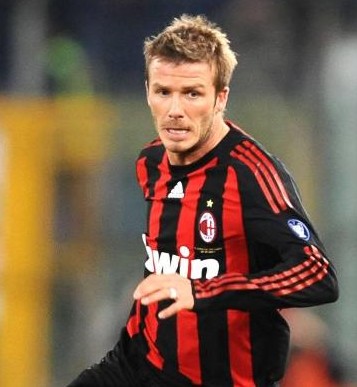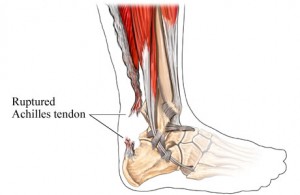David Beckham Hobbled by a Heel

David Beckham has suffered an injury to his left leg. The 34 year old Beckham has been playing with AC Milan to increase his chances to make the international team in the 2010 World Soccer Cup (his 4th) in June . Unfortunately, that probably won’t happen now, as Beckham has ruptured his left Achilles tendon. Recovery is expected to take about 4-6 months. Currently, David Beckham is in Finland to undergo surgical repair of the tendon. “I am upset but [want] to thank everyone for their messages of support,” Beckham said in a statement on his website before his arrival. “I hope to make a swift and full recovery.”
 The Achilles tendon is the strongest and thickest tendon in the human body. It runs from along the back of the calf connecting the large calf muscle (gastrocnemius) with the heel. It facilitates walking by helping to raise the heel off the ground. It is the thick band of tissue you feel at the back of your leg just above the ankle.
The Achilles tendon is the strongest and thickest tendon in the human body. It runs from along the back of the calf connecting the large calf muscle (gastrocnemius) with the heel. It facilitates walking by helping to raise the heel off the ground. It is the thick band of tissue you feel at the back of your leg just above the ankle.
Achilles tendon ruptures, also known as tears, can be full ruptures or partial ruptures. They are most commonly seen in men, 30-40 years old. About 15-20% of patients have symptoms of Achilles tendonitis (inflammation of the tendon) prior to sustaining an Achilles tendon rupture, but most have no history of prior Achilles tendon problems. Over 75% of Achilles tendon ruptures are associated with playing ball sports (commonly basketball or tennis).
The symptoms of Achilles tendon rupture comes on suddenly, sometimes with a pop or snap sound. Frequently it is described as being kicked in the heel, even though that is not the case. In a complete rupture, the calf muscle is no longer connected to the heel, so walking is not possible. On examination, the area of the rupture is often swollen, tender, bruised (ecchymotic), and may actually have a palpable gap in the tendon.
Other risk factors that are associated with Achilles tendon rupture include cortisone injections into the tendon (usually to treat tendonititis, gout, and the use of certain antibiotics, called fluoroquinolones which are commonly used for treatment of respiratory, urinary tract, and other bacterial infections. These antibiotics, such as Cipro, Levaquin, and others, can be associated with Achilles tendon rupture. Exactly why this is the case is unclear.
For more information:
| Resounding Health(tm) Achilles Tendon Rupture |

























0 comments